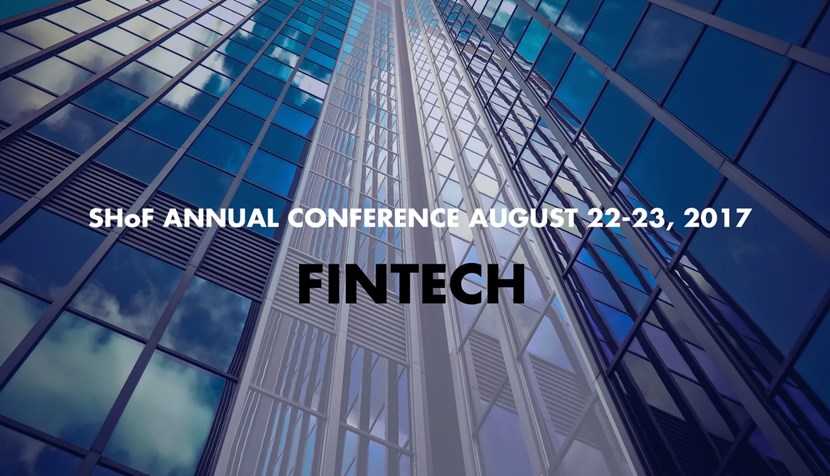Material from the Swedish House of Finance FinTech Conference
aug. 24, 2017
A two-day conference that brought together representatives from the finance industry, regulators, and leading academic scholars. The first day featured key-note presentations and panel discussions aimed primarily towards a non-academic audience. The second day was built around presentations of research papers with comments by invited discussants.

A two-day conference that brought together representatives from the finance industry, regulators, and leading academic scholars. The first day featured key-note presentations and panel discussions aimed primarily towards a non-academic audience. The second day was built around presentations of research papers with comments by invited discussants.
FinTech, the catch-all label for technology-based innovation in finance, promises to simplify and streamline the financial services industry, and even to disrupt or redefine it. While providing ample opportunities, FinTech also raises significant privacy, regulatory and law-enforcement issues that need to be addressed.
The Swedish House of Finance FinTech Conference brought together the leading minds of academia and business to discuss blockchain and digital currencies, crowdfunding and P2P lending, FinTech challenges in asset management and more. Below are some of the key-note presentations, papers and other material from the conference.
Session 1 – Blockchain
Presentations
Mariana Khapko (“Smart” Settlement with Marius Zoican)
Katya Malinova (Market Design with Blockchain Technology with Andreas Park)
The session focused on studying the consequence of introducing blockchain technology in financial markets. In particular, this new technology can have a visible and profound impact on market microstructure. Blockchain technology surely offer more flexibility for market design. However, an innovation does not necessarily benefit everyone as it typically creates winners and losers. In this regard, how to harness the power of blockchain in market design remains as an important open question. The common theme that emerged in the session is that we do not have to let the power of blockchain direct the market to the full extent, but instead we should take a more cautious step by balancing market imperfections. In this way, we will be able to achieve the best possible market liquidity.
One important aspect is optimal settlement timing. Although blockchain allows much faster settlements of transactions than traditional ways, we have to approach this problem by considering its impact on counterparty risk and searching frictions. Another important aspect is market transparency. Using blockchain technology can allow market participants to identify each other more easily. But again, a good market design should incorporate its impact on liquidity provision and risk of front running.
Session 2 – FinTech & RegTech
Presentations
Jiasun Li (Profit Sharing: A Contracting Solution to Harness the Wisdom of the Crowd)
Sanjiv Das (Zero-Revelation RegTech: Detecting Risk through Linguistic Analysis of Corporate Emails and News with Seoyoung Kim and Bhushan Kothari)
Jiasun Li, the first presenter in the session on FinTech and RegTech, talked about how profits should be distributed optimally among crowdfunding investors. Under the assumption of his model, sharing profits equally is preferable to standard common shares that share profits in proportion to invested capital. With profit sharing, investors are exposed to less risk and thereby give more weight to their private information and invest more on average. This contributes to better information aggregation, or in the words of the presenter, “harnessing the wisdom of the crowd”. The presenter used this result to call into question the standard practice of crowdfunding, where many small investors usually obtain common shares of a venture.
In his discussion of the paper, Jungsuk Han asked whether crowdfunding investors care mostly about profits or perhaps non-pecuniary rewards. Members of the audience asked how robust the result was to different assumptions about investors and timing.
Sanjiv Das, the second presenter of the session, talked about how algorithms for scanning the e-mails of employees can be used by regulators to detect fraud and other problems in firms. The presenter and his co-authors had performed this exercise with emails from the employees of Enron, a firm that went bankrupt in 2001 after a corporate scandal involving accounting fraud. Among other things, they found that measures of email sentiment could predict subsequent stock-return and that messages got shorter before the fraud was discovered.
The discussant, Michal Dzielinski, asked how the algorithm could distinguish between corporate scandals and regular downturns. He also wondered if it would be sufficient to scan the emails of the most active employees. Members of the audience asked if employees would not move their conversations elsewhere if it became known that they were scanned.
The topics of the two presentations were quite different, but both addressed the issue of how innovation can improve the functioning of financial markets.
Session 3 – Technology and Markets
Presentations
Carole Comerton-Forde (Inverted Fee Venues and Market Quality with Vincent Gregoire and Zhuo Zhong)
Tetyana Balyuk (Financial Innovation and Borrowers: Evidence from Peer-to-Peer Lending)
Fabio Braggion (Is FinTech a Threat to Financial Stability? Evidence from Peer-to-Peer Lending in China with Alberto Manconi and Haikun Zhu)
The session, to some extent, focused on peer-to-peer lending which seems both a booming area in industry and an active research area. Key questions in this area are whether peer-to-peer lending improves or deteriorates financial stability and whether it is in the interest of consumers or not. For example, peer-to-peer lending might provide access to credit to individuals that otherwise are credit-constrained due to frictions or inefficiencies in the bank lending process. Alternatively, peer-to-peer lending might induce individuals to borrow too much and eventually default on their loans.
Another area in which technology affects markets is market microstructure; i.e., how financial assets are traded on exchanges and other, less-regulated platforms. This is maybe the area in finance where recent and current technological changes have the largest impact. From an academic point of view, key questions, however, still seem to be rather basic ones. For example, how to organize markets (e.g., minimum tick size requirements) given the current and potential future infrastructures.
